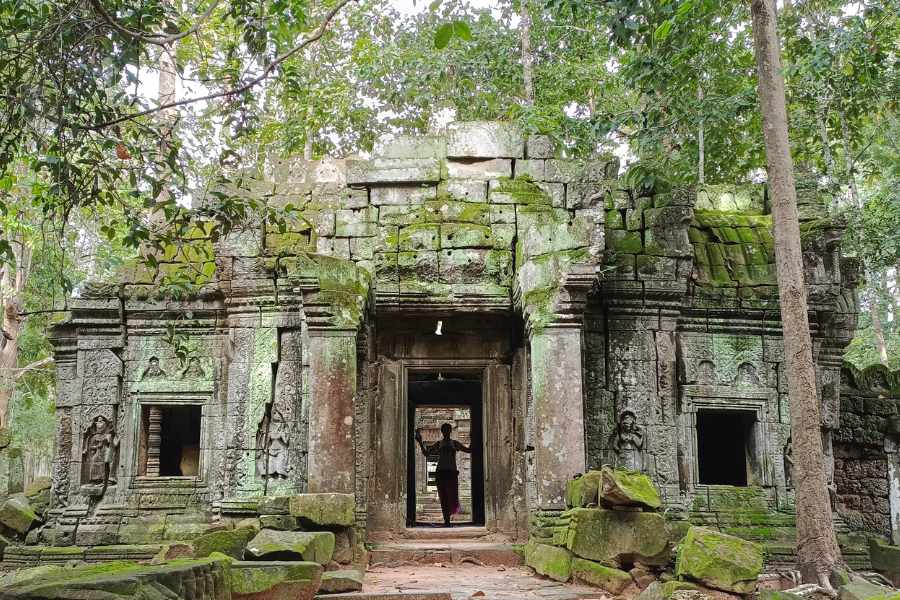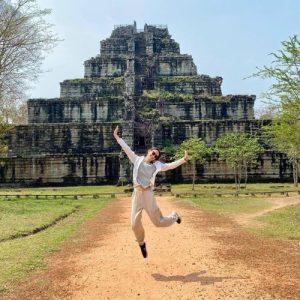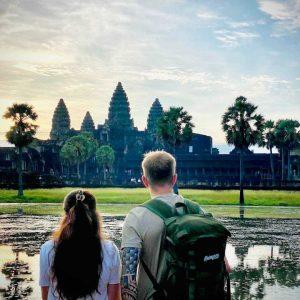Discover the Mysteries of Angkor’s Ta Som Temple
July 30, 2023

Table of Contents
Discover the Mysteries of Angkor’s Ta Som Temple
Ta Som Temple
An Insider’s Guide to the Intriguing 12th Century Temple
Tucked away in the dense jungle of Angkor Thom lies the enigmatic Ta Som temple, one of the many wondrous temple ruins found in the UNESCO World Heritage site of Angkor, Cambodia. Although overshadowed by its more famous neighbor, Angkor Wat, Ta Som holds its own secrets and mysteries waiting to be uncovered by intrepid travelers. Join us on an exploration of this fascinating Ta Som temple, and uncover its history, layout, intricate carvings, and enduring allure.
The History and Significance of Ta Som
Ta Som temple was constructed in the late 12th century during the reign of the Khmer ruler Jayavarman VII, the prolific temple-builder behind Angkor Thom and the Bayon. Built as a dedication to the Hindu gods Shiva and Vishnu, its layout follows a traditional cruciform with a central tower, similar to other structures of the era.
After flourishing for centuries, Ta Som was eventually abandoned and reclaimed by the jungle. It wasn’t until the early 20th century that French archaeologists rediscovered the site while exploring Angkor. Today, it stands as an enduring testament to the incredible accomplishments of the ancient Khmers, as well as a window into their complex cosmology and beliefs.
For history buffs and devotees of Khmer architecture, a visit to Ta Som temple provides unparalleled insight into the evolution of the Angkor complex. As one of the last major temples constructed before the fall of the empire, it demonstrates how Hinduism gradually gave way to Theravada Buddhism and foreshadows the decline of the kingdom.
Exploring the Layout and Design of Ta Som Temple
Stepping through the eastern gopura entrance of Ta Som temple, visitors are greeted by a stone causeway flanked by naga balustrades that guides the eye towards the central sanctuary tower. The iconic without lions guard the staircases, while deva guardians keep watch from the corner pavilions.
The interior eastern gallery features an enclosed hallway with windows that filter light in patterns, creating an ethereal atmosphere. Patches of lichen and moss cling to the weathered sandstone walls, complementing the emerald hues of foliage pressing in from the jungle.
At the heart of the temple stands the main central tower, or prang. Though not as lofty as Angkor Wat’s signature spires, Ta Som’s prang still reaches towards the sky at nearly 50 feet tall. Intricate carvings of female divinities called devatas decorate the porches, their enigmatic smiles staring out as if sharing mysterious secrets.
Linking the central tower to the corner pavilions are cruciform galleries, many still holding up relatively well despite the erosive forces of nature. The overall layout exemplifies the harmonious relationship between architecture and the natural world found in Khmer design.
Marveling at the Intricate Bas Relief Carvings
No exploration of Ta Som temple would be complete without spending time marveling at its exquisite bas relief carvings. Graceful apsaras dance across walls, while scenes from Hindu mythology depicted include the classic Churning of the Sea of Milk, Vishnu Reclining on the Cosmic Ocean, and depictions of everyday life such as a cockfight.
Some carvings remain partially unfinished, providing a glimpse into the incredible skill required to create these masterpieces. The level of detail is awe-inspiring, with flowing fabrics, expressive poses, and intricate jewelry carved into the sandstone facade.
Sadly, some carvings have been damaged or looted over the centuries, but what remains still exhibits the high level of artistry achieved by Khmer sculptors. To come face to face with these ancient carvings is to be transported back to the temple’s heyday as a thriving religious site.
How Nature Has Reclaimed the Temple
Part of the mystical appeal of Ta Som comes from how intricately nature has reintegrated itself into the temple’s fabric. Massive kapok tree and strangler fig roots twist around walls, while vegetation springs from cracks and crevices in the stone structures. Moss covers carvings in a velvety green sheen, and lichen creeps across old sandstone blocks adding texture and patina.
It’s remarkable to contemplate how this once-gleaming temple was swallowed up by jungle overgrowth for centuries before its rediscovery. The dynamic tension between nature’s relentless force and human architectural ambition on display at Ta Som is breathtaking to behold.
The temple’s most photographed spot is the eastern gate, where a giant strangler fig tree grows on top of the gopura. The gnarled roots resemble tentacles grasping the stones as if determined to crush the portal. Visitors can even climb a wooden staircase to reach the top for an elevated perspective of the tree’s destructive powers.
This interplay between nature and human civilization is a poignant reminder of the temporal nature of even our greatest creations. Ta Som serves as a humbling metaphor for the ultimate ephemerality of earthly kingdoms and hubris.
Visiting Ta Som Temple
Ta Som temple is located within the ancient walled city of Angkor Thom, in the northern section. Visitors with multi-day Angkor Archaeological Park passes can easily access the temple via the small road leading to the east gopura entrance.
Alternatively, to arrive in true Khmer style, consider a backcountry tour by traditional ox cart from Siem Reap. Rumbling down rural dirt paths under jungle canopy before emerging at Ta Som makes for an unforgettable experience. Explore other lesser-visited temples like Banteay Srei before returning to town for a well-deserved Khmer massage.
When planning your visit, try going in the early morning or late afternoon when the lighting creates dramatic shadows and the crowds are smaller. The one-two punch of exploring the layout, admiring the carvings, and seeing the fusion of structure and nature is sure to make Ta Som temple an Angkor highlight.
A shining example of late 12th century Khmer temple architecture, the mystical Ta Som temple offers adventurous travelers much to discover. Beyond its aesthetic beauty, its enduring presence is a testament to the ambitious spirit of its creators and the indomitable life force of the jungle that claims it. So join the tradition of intrepid explorers who have long journeyed to marvel at Angkor’s wonders, and uncover your own connection to the past at the enigmatic and evocative Ta Som temple.
Let’s now see the most relevant questions about Ta Som Temple so you can better understand this impressive Temple before you visit it!
- What is the history of the Ta Som temple?
- What does the layout and design of the Ta Som temple look like?
- What are some of the notable bas relief carvings at Ta Som?
- How has nature reclaimed parts of the Ta Som temple over time?
- What is the best time of day to visit the Ta Som temple?
- How can I get to the Ta Som temple from Siem Reap?
- What stands out about the architecture of the Ta Som temple?
- Is it worth visiting Ta Som in addition to Angkor Wat?
- What interesting facts should I know about Ta Som before visiting?
What is the history of the Ta Som temple?
The mysterious Ta Som temple has a fascinating history spanning over 800 years. Constructed in the late 12th century during the reign of King Jayavarman VII, it was one of the last major temples built at Angkor before the fall of the mighty Khmer Empire.
Ta Som temple was dedicated to the Hindu gods Shiva and Vishnu, the two most important deities in the Khmer state religion at the time. Its layout follows a traditional cruciform pattern with a lofty central tower and galleries connecting to smaller towers at each corner. Exquisite carved bas reliefs depicting scenes from classic Hindu myths adorn many of its walls.
After the decline of Angkor, Ta Som temple was abandoned and slowly reclaimed by the jungle. For centuries it remained largely unknown, buried under roots and foliage, before eventually being rediscovered and cleared in the early 20th century by French archaeologists.
Today, it stands as a testament to both the incredible accomplishments of the ancient Khmers as well as the unrelenting power of nature to swallow man’s creations. Visitors can marvel at its elegant carvings while also witnessing the temple’s ongoing fusion with the surrounding forest.
What does the layout and design of the Ta Som temple look like?
The layout of Ta Som temple exemplifies classic Angkorian cruciform temple design. Approaching from the east, visitors cross an elegant stone causeway decorated with naga balustrades to reach the gopura entrance. This is the famous spot where a giant strangler fig tree grows over the gate.
Inside, a central hallway leads to the heart of the temple: a lofty sandstone tower called a prang soaring nearly 50 feet into the air. Galleries lined with exquisite carvings connect this central shrine to smaller towers at each corner of the temple.
Visual symmetry and harmonic proportions were very important to Khmer architects. The overall composition strikes a delicate balance between the manmade temple structures and the natural environment. Decorative flourishes like carved apsaras, dancing nymphs, and celestial beings adorn the many pillars and lintels.
Despite damage from time and looting, much of the original layout is still intact enough to provide a powerful sense of the mystical grandeur its architects achieved. The open galleries create picturesque frames of jungle scenery while allowing light to filter in magical ways.
What are some of the notable bas relief carvings at Ta Som?
Ta Som temple contains an absolute wealth of intricate bas relief carvings that should not be missed. These ancient sandstone carvings offer a vivid glimpse into the Khmer Empire’s Hindu-influenced cosmology as well as everyday life.
Some of the most impressive carvings include:
- A lintel depicting the “Churning of the Sea of Milk” from Hindu mythology
- Carvings of Vishnu reclining on the cosmic ocean while Lakshmi massages his feet
- Elegant apsaras, or celestial nymphs, dancing across pillars and walls
- Scenes of ritual animal sacrifice and everyday activities like cockfighting
- Partially unfinished carvings showing the incredible workmanship involved
Many carvings remain remarkably crisp and refined in detail despite centuries of exposure to the elements. The smooth sandstone provides the perfect canvas for bringing these intricate mythological stories and heavenly beings to life.
Devatas, or female divinities, smile enigmatically from their perches. Dancers pose lithely in flowing robes that seem ready to flutter at any moment. Lost in these carvings, one can easily imagine slipping back centuries to the temple’s active past life.
How has nature reclaimed parts of the Ta Som temple over time?
One of the most beguiling aspects of Ta Som temple is witnessing how intricately nature has fused itself back into the structures over time. Enormous tree roots now grasp walls and encircle carved blocks of sandstone. Delicate mosses and verdant lichens have colored the weathered facades in emerald hues.
The most famous example is the giant strangler fig growing on top of the eastern gopura entrance. These fast-growing trees start as epiphytes high up on other trees before sending roots down to envelop and choke their host tree. The tentacle-like fig roots seem to almost crush the Ta Som gateway as they reach down for soil.
Inside, vegetation can be seen sprouting from cracks and crevices between blocks of stone. The temple’s roofs and towers have long since collapsed, allowing thick foliage to fill the interiors. Witnessing the relentless power of the Cambodian jungle reclaiming human structures inspires awe at nature’s life force.
This invincible fusion of the natural world and crumbling ancient ruins creates Ta Som’s distinctive, almost mystical atmosphere for visitors to soak in. One can truly feel the temporal nature of human achievements here, swallowed by jungle which in turn is now intertwined with the temple itself.
What is the best time of day to visit the Ta Som temple?
The Ta Som temple is captivating at any time of day, but early morning and late afternoon are perhaps optimal for photography and avoiding crowds.
In the early hours before sunrise, a blue haze permeates the temple while shadows cling to its nooks and corners. Only bird calls pierce the silence. This peaceful atmosphere lets you imagine encountering Ta Som just as its early explorers did.
At sunset, the warm, low light casts a golden aura over the sandstone, bringing out the muted tones of weathered carvings. Long shadows accentuate aspects of the layout. The jungle takes on an iridescent green sheen under the gilded light.
The midday sun can be quite harsh and tends to bleach out some details in the carvings. Since Ta Som is smaller and more niche than Angkor Wat, it also receives fewer visitors in the early morning and late afternoon hours. For photography, lighting, and avoiding crowds, these times are ideal.
How can I get to the Ta Som temple from Siem Reap?
The ancient temple city of Angkor, including Ta Som temple, is just a few miles north of Siem Reap. Tuk-tuks offer an inexpensive and easy way to reach Ta Som, for around $15-20 per day. Drivers are very familiar with the major Angkor temples.
For a more immersive experience, consider booking an ox cart countryside cycling tour directly from Siem Reap. Meandering down rural dirt trails by traditional ox cart to reach Ta Som temple offers a sense of adventure and glimpse of daily life.
Another option is hiring a private car and driver for the day. This offers air conditioned comfort and flexibility for your own customized temple itinerary. Hotels and tour agencies in Siem Reap offer private car services.
No matter how you arrive – tuk-tuk, cycling tour, or private car – Ta Som temple is conveniently located just over an hour’s drive from the heart of Siem Reap along good paved roads.
What stands out about the architecture of the Ta Som temple?
The graceful Khmer architecture of Ta Som temple exemplifies the pinacle achievements of the great 12th century temple builders. Its cruciform layout combines harmony, symmetry, and intricacy.
The centerpiece is the lofty sandstone central tower, or prang, which rises in three tiers to almost 50 feet. Supported by columns and surrounded by connected galleries, this soaring focal point dominates the low jungle horizon.
Delicate carved ornaments like dancing apsaras, or celestial nymphs, adorn the many architraves, lintels, and pillars. Repeating geometric motifs echo throughout the complex, unifying the various structures into a cohesive whole.
Ta Som contains classic elements found in many great Angkorian temples, from imposing gopuras to devatas in serene poses staring out from pillars. Its beguiling fusion of architecture and nature is enhanced by the ancient bricks, weathered sandstone, and jungle overgrowth.
While smaller in scale than Angkor Wat, Ta Som rewards visitors with an intimate glimpse into the ingenious methods, sophisticated style, and almost otherworldly architectural vision of Cambodia’s ancient Khmer civilization.
Is it worth visiting Ta Som in addition to Angkor Wat?
Visiting the Ta Som temple makes for a perfectly complementary addition to the iconic Angkor Wat during any trip to Siem Reap. Although lesser known, Ta Som rewards temple devotees with:
- Intricate carvings in excellent condition that rival Angkor Wat’s artistry
- A layout and structure that elegantly fuse architecture and nature
- Far fewer crowds than at perennially busy Angkor Wat
- A mystical, ancient atmosphere from being partially overgrown by jungle
- Unique tree roots entangled around temple stones and gateways
- An off-the-beaten-path feel despite being located near Angkor Wat
For travelers with multi-day passes, Ta Som adds diversity and depth to exploring the many temples of Angkor. It encapsulates the enduring blend of nature and human ambition that defines Angkorian Khmer architecture. The relief carvings also showcase the impressive talents of ancient artisans.
Beyond the awe-inspiring Angkor Wat and Bayon, no visit to Siem Reap is complete without spending time at the evocative and romantic Ta Som temple hidden amidst jungle and rice fields.
What interesting facts should I know about Ta Som before visiting?
As you explore the ancient sandstone galleries and leafy environs of Ta Som temple, keep this temple trivia in mind:
- Constructed late 12th century during the reign of Jayavarman VII
- Dedicated to the Hindu gods Shiva and Vishnu
- Cruciform layout with a central prang (tower) and connecting galleries
- Intricately carved depictions of Hindu myths on walls and lintels
- Part of the Angkor complex, but often less crowded than Angkor Wat
- Left to be reclaimed by jungle growth for centuries before re-discovery
- Home to the famed eastern gopura with a giant strangler fig tree on top
- Showcases the blend of human craftsmanship and nature found in Khmer temples
- Sandstone blocks have been partially dismantled by looters over time
Visiting this enduring temple, hidden for generations and fused with the surrounding forest, is sure to be a highlight of any trip to magical Angkor.
Recent Post
Get 30% Discount Now
Categories
Guided Tours

Private Siem Reap Airport SAI Transfers – Siem Reap Airport Pick-up or Drop-off, Just for You!
From: 30$
Shared SAI Siem Reap Airport Transfer – We depart every 1 hour!
From: 9$
Private Full-Day Siem Reap to Koh Ker & Beng Mealea Temple Tour
From: 75$
2-Day Angkor Wat Sunrise & Banteay Srei Grand Tour – Small Group Tours
From: 30$
2-Day Angkor Wat Temple Sunset and Floating Village Tour
From: 40$
3-Day Angkor Wat Sunrise, Banteay Srei and Floating Villages Tour – Small Group Tours
From: 50$